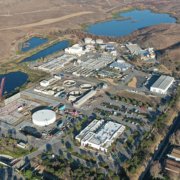Water Authority Recommends 0% Change in Next Two-Year Budget
The San Diego County Water Authority’s general manager today recommended to the Board of Directors a $1.7 billion budget for fiscal years 2022 and 2023 – a 0% change from the current two-year budget – due to the agency’s continuing commitment to cost control.
Water Authority staff also proposed increasing rates and charges for member agencies by 3.6% for treated water and 3.3% for untreated water in calendar year 2022, attributable to more rate increases by the Water Authority’s wholesaler, continued payments for past investments in supply reliability, and inflationary pressures on energy, chemicals, and construction materials.
Although the Water Authority’s budget spans two fiscal years, the agency sets rates annually to manage changing conditions more effectively. The Water Authority Board is expected to vote on rates for next year and the two-year budget at its regular meeting on June 24, following budget workshops on June 8 and 10.
“Major accomplishment”
“Proposing a flat budget is a major accomplishment made possible by strategic guidance from the Board of Directors, input from our member agencies, and the dedication of agency staff who are committed to resilient operations, forward-thinking plans, and regional collaboration,” said Water Authority General Manager Sandra L. Kerl. “The pandemic and economic recession, combined with a second consecutive dry year, created unprecedented challenges, yet we have contained costs while continuing to deliver enough water to sustain our region’s $253 billion economy and quality of life.”
As usual, more than 90% of the Water Authority’s recommended budget is for buying and treating water or building and financing infrastructure. This reflects the Water Authority’s long-term strategy to invest in supply reliability to meet current and future needs of the San Diego region – a strategy that is paying significant dividends during the current drought hitting most of California.
Seven percent of the budget funds the Water Authority’s operating departments. The recommended budget proposes increasing spending by those departments by 1%, or $1.1 million, compared to the current two-year budget.
Key initiatives the Water Authority plans to pursue during the next two-year budget cycle include:
- Long-term planning – The Water Authority’s Long-Range Financing Plan and the Water Facilities Master Plan will be prioritized. Both are critical documents for projecting the Water Authority’s financial future and providing the Board with flexibility. Phase B of the Regional Conveyance System Study will conclude, and the Board will determine whether to proceed. Another focus is developing water storage capacity in Lake Mead to provide additional drought resilience for San Diego County and other parts of the Colorado River Basin.
- Controlling costs – The recommended budget includes the elimination of eight staff positions, along with a reduction in outside services and minimizing travel. In addition, equipment replacement was evaluated for deferrals, minimizing the budget impact of day-to-day operations. As always, the budget is partly the function of water sales and water rates, which are both trending upward.
- Capital improvements – The Water Authority’s Capital Improvement Program is the cornerstone of the agency’s efforts to ensure that regional water delivery and treatment systems continue to meet a variety of ever-changing demands. The agency will move forward on the highest-priority asset management projects, along with detailed seismic, hydraulic and cavitation analysis. Staff also will continue to enhance security systems for physical and cyber assets – a responsibility that grows as potential threats continue to expand.
- Collaborating with member agencies – Water Authority staff in every department work closely with member agencies to support local efforts, from outreach and advocacy to budget and rate development – and those efforts will continue to be a priority. There are opportunities for collaboration both in joint projects and joint policy issues, such as advocating for local decision-making about drought investments and responses.
- Communicating with stakeholders – Whether it be in the state Capitol or local chambers of commerce, the Water Authority will continue to share the region’s water story through a full range of engagement tools and creative tactics.
To support the recommended budget, the Water Authority developed its 2022 rate proposal in conjunction with an independent cost-of-service study to ensure rates and charges comply with state law, legal requirements, cost-of-service standards, and Board policies. The Water Authority also worked closely with its member agencies to keep the proposed rates and charges at the low end of earlier projections.
In 2022, the Water Authority proposes charging its 24 member agencies an all-in rate of $1,523 per acre-foot for untreated water, or $49 more per acre-foot than they currently pay. Charges would be $1,833 per acre-foot for treated water, or $64 more per acre-foot than in 2021. (Note: An acre-foot is about 325,900 gallons, enough to serve the annual needs of 2.5 typical four-person households in San Diego County.)
Actual figures will vary by member agency, and each member agency will incorporate costs from the Water Authority into the retail rates it charges to residents, businesses, and institutions.
Prudent financial planning
The Water Authority’s overall rate increase is driven by multiple factors, including rising costs from its wholesale water provider, the Metropolitan Water District of Southern California (up 3.9%), which increased its rates and charges, including the amount it charges to transport the Water Authority’s independent Colorado River supplies.
“Thanks to prudent financial planning and debt management, we are able to keep the proposed rates at the low end of our projections,” said Water Authority Finance Director Lisa Marie Harris. “We’ve worked hard to control rates while maintaining a complex water production, treatment and delivery system that will continue to support the region for generations.”
The rate proposal for Calendar Year 2022 includes strategic withdrawals from the Rate Stabilization Fund. To reduce 2022 rate increases by approximately $65 per acre-foot, the Water Authority plans to draw $25 million from the agency’s Rate Stabilization Fund. The fund was created in 1990 to help avoid rate spikes, especially those driven by reduced water sales. The rate proposal also includes strategic management of the Water Authority debt portfolio resulting in $130 million in net present value savings from several refundings.
The 2022 rate proposal ensures debt-coverage ratios that maintain the Water Authority’s strong credit ratings and minimize the cost of borrowing money for construction projects, an approach that saves ratepayers money over the long run. The Water Authority has senior lien credit ratings of AAA from Standard & Poor’s, AA+ from Fitch ratings and Aa2 from Moody’s.
For more information about the Water Authority’s recommended 2022 and 2023 budget, and proposed 2022 rates, go to pages 72 and 73 of the May Board packet at https://www.sdcwa.org/wp-content/uploads/2020/11/2021_05_27FormalBoardPacketSEC.pdf.






 Sweetwater Authority Logo 2019
Sweetwater Authority Logo 2019


